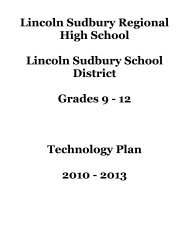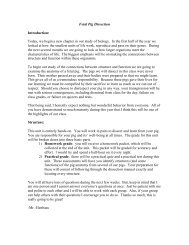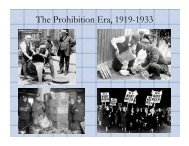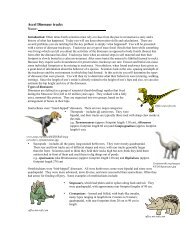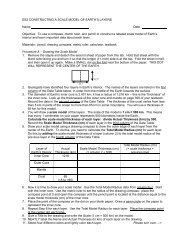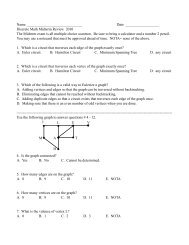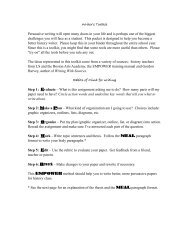atmosphere layers lab - LS Home Page
atmosphere layers lab - LS Home Page
atmosphere layers lab - LS Home Page
You also want an ePaper? Increase the reach of your titles
YUMPU automatically turns print PDFs into web optimized ePapers that Google loves.
Layers of the <strong>atmosphere</strong> activity<br />
Name:_______________________<br />
Block:_____<br />
The earth's <strong>atmosphere</strong> is 100km thick and is broken into 4 <strong>layers</strong> due to differences in composition and<br />
temperature. In this activity you will investigate the changes and try to figure out why the te,pmerature<br />
changes the way it does.<br />
Make a graph of altitude on the y axis and temperature on the x axis. The altitude range should go from 0<br />
to 150km. The temperature range should go from -100 to +300°C. Then plot the following points and<br />
connect them with a solid line as you go. Use a ruler.<br />
Altitude Temperature Altitude Temperature<br />
0 17 70 -60<br />
5 -26 80 -90<br />
10 -55 90 -90<br />
12 -58 100 -78<br />
15 -58 110 -32<br />
20 -58 120 87<br />
25 -52 130 113<br />
30 -47 140 139<br />
35 -35 150 165<br />
40 -23 160 191<br />
45 -10 170 217<br />
48 -2 180 243<br />
52 -2 190 269<br />
55 -10 200 295<br />
60 -28<br />
The <strong>layers</strong> of the <strong>atmosphere</strong> are called the troposphere=layer closest to earth; stratosphere, mesosphere,<br />
and thermosphere. The boundaries of these <strong>layers</strong> are called pauses---the places where the temperatures<br />
stopped decreasing or increasing.<br />
1. Find the first place above the surface the temperature stayed the same. Label this spot as the tropopause.<br />
Between the surface and the tropopause is the troposphere. Color the troposphere red.<br />
2. Find the second place above the surface that the temperature stayed constant. Label this the stratopause.<br />
The altitudes between the stratopause and the tropopause contains the stratosphere. Color the<br />
stratosphere yellow.<br />
3. The last place the temperature stopped changing is called the Mesopause. Label it.<br />
4. The altitudes beween the mesopause and stratopause is the mesosphere. is called the Mesosphere. Color<br />
the mesosphere green. The area above the mesopause is the thermosphere. Color it Blue.<br />
5. Make two horizontal lines. One at 38km and another at 50km. Label the portion in between the two<br />
lines as the ozone layer.<br />
6. Clouds form between 1 and 10km above the surface. Label this “weather”
Answer the following (use your textbook to assist!)<br />
1. Based on your graph, what would be the approximate temperature of the air at the top<br />
of Mount Washington (about 1.9 km). ________ What layer of the <strong>atmosphere</strong> is this<br />
_________________<br />
2. What would be the temperature outside of an airplane at 9km? _____________ What<br />
layer is this in? _______________<br />
3. What layer would be responsible for our weather?__________________________<br />
4. At what altitude is the coldest air? _____________________What layer is<br />
this?______________________<br />
5. Which layer is the thinnest? __________________What is its thickness?___________<br />
6. Which layer is thickest?_____________________What is its thickness?<br />
7. 99% of all air is found between 0 and 32km. What layer has the most air?<br />
8. The melting point of lead is around 300 degrees C. Which layer gets hot enough to<br />
melt lead?<br />
9. What happens to the temperature in the troposphere? ________________________<br />
WHY does this happen? Use your book to help. ___________<br />
10. What happens to the temperature in the stratosphere? WHY?<br />
________________________________________________________________________<br />
________________________________________________________________________<br />
________________________________________________________________________<br />
_<br />
11. What is the composition (what gases make up) of the thermosphere (use your book)?<br />
_________________ and<br />
. How does the composition affect<br />
the temperature of this layer?<br />
________________________________________________________________________<br />
12. Knowing that only long wave radiation of the electromagnetic spectrum reaches<br />
earth’s surface, what kinds of rays of the electromagnetic spectrum are most likely<br />
absorbed in the thermosphere?<br />
________________ _____________________ and .
13. Why d you think the mesosphere decreases in temperature with altitude?<br />
14. Calculate the average drop in temperature for the first 12 km of Earth’s <strong>atmosphere</strong>.<br />
Show how you are setting up your calculation.<br />
15 Make a chart listing the four <strong>layers</strong> use your book and this activity to summarize the<br />
key characteristics of each<br />
Troposphere Stratosphere Mesosphere Thermosphere



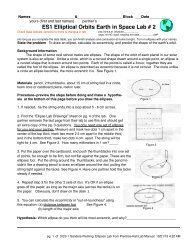


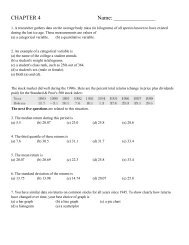


![';1asAu ro; las I sgeo8 leuo!]eslanuol aql utelqo o1 palenttouJ ue I ...](https://img.yumpu.com/49072782/1/190x221/1asau-ro-las-i-sgeo8-leuoeslanuol-aql-utelqo-o1-palenttouj-ue-i-.jpg?quality=85)
